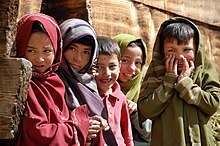Balti people
 Balti children photographed in Tarishing, Gilgit−Baltistan in September 2008 | |
| Total population | |
|---|---|
| c. 393,000[1] | |
| Regions with significant populations | |
| Gilgit−Baltistan, Pakistan Ladakh, India[2] | |
| Languages | |
| Balti, Hindi–Urdu | |
| Religion | |
(predominantly Shia Islam,[3] small minorities of Noorbakshia Sufi Islam and Sunni Islam in Pakistan and India[4]) | |
| Related ethnic groups | |
| Tibetans, Purigpas, Ladakhis, Dardic |
The Baltis are a Tibetic ethnic group who are native to the Pakistani-administered territory of Gilgit−Baltistan and the Indian-administered territory of Ladakh, predominantly in the Kargil district with smaller concentrations present in the Leh district. Outside of the Kashmir region, Baltis are scattered throughout Pakistan, with the majority of the diaspora inhabiting prominent urban centres such as Lahore, Karachi, Islamabad and Rawalpindi.
Origin
The origin of the name Balti is unknown.
Language
The Balti language belongs to the Tibetic language family. Read (1934) considers it to be a dialect of Ladakhi,[8] while Nicolas Tournadre (2005) instead considers it to be a sister language of Ladakhi.[9]
Religion
Bön and Tibetan Buddhism were the dominant religions practiced by the Balti people until the arrival of Islam in Baltistan by the 14th century CE, predominantly through Sufi missionaries such as Mir Sayyid Ali Hamadani. The Noorbakshia Sufi sect further propagated the Islamic faith in the region, and most of the Balti people had converted to Islam by the end of the 17th century.[10]
Over time, a significant number of Baltis converted to Shia Islam, while a few converted to Sunni Islam.
The Baltis still retain many cultural traits of pre-Islamic Bön and Tibetan Buddhist rituals within their society, making them a unique demographic group in Pakistan.[11] The Balti language remains highly archaic and conservative, closer to Classical Tibetan than other Tibetan languages.
Baltis see congregation in
Mosques in Baltistan are predominantly built in the Tibetan style of architecture, though several mosques have wood-finishings and decorations in the Mughal style, which is also seen in the Kargil district of Indian-administered Ladakh, across the Line of Control.
Today, around 60% of Baltis are Shia Muslims, while some 30% practice Noorbakshia Sufi Islam, and 10% are Sunni Muslims.[12][10]
In India, 97% of Baltis are Muslims and 3% of Baltis are Buddhists.[4]
See also
- Gilgit−Baltistan
- Balti language
- Balti (dish)
- Mayfung
- Purigpa
- Tibetan Muslims
- Three Cups of Tea, a book about an American humanitarian involved in building schools in Baltistan (as part of a larger AfPak campaign)
- Sart
References
- ^ Ahmed, Musavir (29 January 2021). "Balti: Protecting the language". Greater Kashmir. Archived from the original on 11 July 2021. Retrieved 3 October 2021.
- ^ "In pictures: Life in Baltistan". BBC News. 1 July 2013. Retrieved 3 October 2021.
- ISBN 978-81-85431-96-3.
- ^ a b "Census of India Website : Office of the Registrar General & Census Commissioner, India". www.censusindia.gov.in. Retrieved 31 May 2021.
- ISBN 9698023127.
- ^ Afridi, Banat Gul (1988). Baltistan in history. Peshawar, Pakistan: Emjay Books International. p. 9.
- ISBN 8124103453.
- ^ Balti Grammar, by A. F. C. Read. London: The Royal Asiatic society, 1934.
- ^ * N. Tournadre (2005) "L'aire linguistique tibétaine et ses divers dialectes." Lalies, 2005, n°25, p. 7–56 [1]
- ^ a b "Little Tibet: Renaissance and Resistance in Baltistan". Himal Southasian. 30 April 1998. Retrieved 20 May 2020.
- ^ "The Nurbakhshi religion in Baltistan". Baltistan Foundation. Archived from the original on 3 June 2019. Retrieved 7 March 2018.
- ISBN 9788185431963.
Further reading
- Muhammad Yousuf Hussainabadi, 'Baltistan per aik Nazar'. 1984.
- Hussainabadi, Mohamad Yusuf. Balti Zaban. 1990.
- Muhammad Yousuf Hussainabadi, 'Tareekh-e-Baltistan'. 2003.
- Addition of new four letter to tibetan scripts by Yusuf Hussainabadi Indian Muslim.
- Akhond Muhammad Hussain Kashif "Malumaat e Gilgit Baltistan" 2013.
- Shumal kay Sitarey by Ehsan Ali Danish Sermik.
- Azadi e Gilgit Baltistan by Muhammad Yousuf.
- Documentary film, [2] Fathima the Oracle (2020, dir. Geleck Palsang), [3] description at IMDB.com
